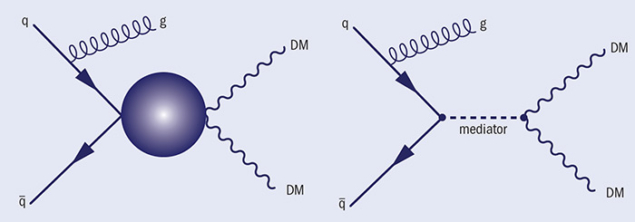
The search for particles that could constitute dark matter in the universe relies on detecting their interplay with the Standard Model particles through a three-pronged approach: via direct-detection experiments, via indirect-detection experiments, and with hermetic detectors at colliders, covering the full 4π-phase space. Because dark matter behaves as a weakly interacting neutral particle, it escapes the detectors without interacting, so in collider experiments its production is inferred by measuring the imbalance in transverse momentum left in the detector. At the LHC, a search for the pair production of dark-matter particles can be performed by looking for events with a large momentum imbalance in association with initial-state radiation of either a jet or a photon – the “monojet” or “monophoton” searches.

The CMS collaboration now has results based on proton–proton collision data collected at a centre-of-mass energy of 8 TeV, amounting to 20 fb–1 of integrated luminosity. In the analysis, both monojet and monophoton searches employ a “cut-and-count” approach. A set of cuts is applied to select potential dark-matter events and, at the same time, to reduce the contamination from Standard Model processes.

One of the dominant and irreducible backgrounds for both searches is the decay of the Z boson into neutrinos, which accounts for roughly 60–70% of the total monojet/monophoton events. The searches look for an excess of events above those expected from the Standard Model processes. In the absence of an excess, limits can be placed on the pair production of dark-matter particles. The results are presented within the framework of an effective field theory where a contact interaction is assumed between the dark-matter and Standard Model particles. Because the effective field theory is not valid for the full parameter space probed at the LHC, the searches are also interpreted in the context of a simplified model with an s-channel mediator. Both assumptions are depicted in the Feynman diagrams in figure 1.

The results (see figure 2) show that CMS extends the sensitivity to spin-independent dark-matter–Standard Model interactions including a vector operator to dark-matter masses that are lower (below 5 GeV) than is currently accessible to the direct-detection experiments. For spin-dependent interactions that include an axial-vector operator, the sensitivity of CMS (not shown here) extends down to dark-matter–nucleon cross-sections of 10–41 cm2. If the particle mediating the dark-matter–Standard Model interaction is accessible at LHC energies, CMS has the opportunity to search for the mediator itself. Figure 3 shows the constraints placed on the mass and coupling strengths of vector-mediator interactions in the monophoton analysis.
The LHC plays a significant role in the search for dark matter and complements well the searches by the direct-detection experiments. The CMS collaboration is now looking forward to intensifying the search with data at 13 TeV and opening up a completely new energy regime to spot hints of dark-matter particles.







